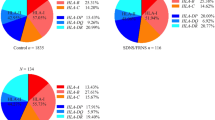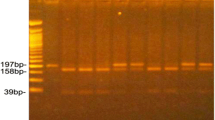Abstract
This study was conducted to test the hypothesis that analysis of HLA class II type alleles will give important information on the prognosis of NS in children. We prospectively studied 100 consecutive children with idiopathic nephrotic syndrome and 202 controls belonging to the same geoethnic background. Typing for HLA Class II alleles at DR and DQ locus was carried out by using SSP (sequence specific oligonucleotides based method). In our study children were more likely to have nephrotic syndrome if the allele DQ-β1*020X was present as compared to controls. On the other hand, DR-β1*1001, DR-β1*130X and DQ-β1*030X were significantly lower among patients and likely to be protective. On analysing the different steroid response categories, we observed that the allele DQ-β1*020X was significantly higher in infrequent relapsers (IFR) with a high etiological fraction of 0.714. Children were more likely to be steroid resistant if the allele DR-β1*150X was present and the etiological fraction was high (0.754). The allele DQ-β1*030X was significantly lower in steroid resistant patients (p=0.019, RR=0.1819, 95% CI=0.04430–0.7471) and likely to be protective. On analysing the haplotype distribution, we observed that occurrence of DR-β1*070X-DQ-β1*020X haplotype was significantly more common among patients with steroid sensitive nephrotic syndrome (23.94%) as compared to controls (12.5%) (p=0.01). In the steroid resistant group we observed that the haplotype DR-β1*150X-DQ-β1*060X was significantly more frequent as compared to steroid sensitive patients as well as controls p=0.01. We conclude that HLA typing in Indian children with NS helps to predict relapse frequency and steroid resistance.
Similar content being viewed by others
References
Sharples PM, Poulton J, White RH (1985) Steroid responsive nephrotic syndrome is more common in Asians. Arch Dis Child 60:1014–1017
Bouissou F, Meissner I, Konrad M, Sommer E, Mytilineos J, Ohayon E, Sierp G, Barthe B, Opelz G, Cambon-Thomsen A, Scharer K (1995) Clinical implications from studies of HLA antigens in idiopathic nephrotic syndrome in children. Clin Nephrol 44:279–283
Laszlo A, Kaiser G, Turi S, Bodrogi T (1984) Typing of HLA antigens in a child population with nephrosis syndrome. Acta Paediatr Hung 25:241–245
Haeffner A, Abbal M, Mytilineos J, Konrad M, Krammer I, Bouissou F, Opelz G, Scharer K, Cambon-Thomsen A (1997) Oligotyping for HLA-DQA, -DQB, and -DPB in idiopathic nephrotic syndrome. Pediatr Nephrol 11:291–295
de Mouzon-Cambon A, Bouissou F, Dutau G, Barthe P, Parra MT, Sevin A, Ohayon E (1981) HLA-DR7 in children with idiopathic nephrotic syndrome. Correlation with atopy. Tissue Antigens 17:518–524
Adhikari M, Coovadia HM, Hammond MG (1985) Associations between HLA antigens and nephrotic syndrome in African and Indian children in South Africa. Nephron 41:289–292
Kobayashi Y, Chen XM, Hiki Y, Fujii K, Kashiwagi N (1985) Association of HLA-DRw8 and DQw3 with minimal change nephrotic syndrome in Japanese adults. Kidney Int 28:193–197
Lagueruela CC, Buettner TL, Cole BR, Kissane JM, Robson AM (1990) HLA extended haplotypes in steroid-sensitive nephrotic syndrome of childhood. Kidney Int 38:145–150
Zaki M, Daoud AS, al Saleh QA, al Najedi AK, White AG (1994) HLA antigens in Arab children with steroid-responsive nephrotic syndrome. Pediatr Nephrol 8:74–75
Tumer N, Ekim M, Yalcinkaya F, Cakar N, Ensari C (1995) HLA-system and the frequency of relapses in childhood minimal change nephrotic syndrome in Turkish children. Acta Paediatr Jpn 37:419–421
Al-Eisa AA, Haider MZ, Srivasta BS (2000) HLA-DRB1 alleles in Kuwaiti children with idiopathic nephrotic syndrome. Pediatr Nephrol 15:79–81
Cheung W, Ren EC, Chan SH, Gong WK, Yap HK (2002) Increased HLA- A*11 in Chinese children with steroid-responsive nephrotic syndrome. Pediatr Nephrol 17:212–216
Bakr AM, El-Chenawi F, Al-Husseni F (2005) HLA alleles in frequently relapsing steroid-dependent and -resistant nephrotic syndrome in Egyptian children. Pediatr Nephrol 20:159–162
Kari JA, Sinnott P, Khan H, Trompeter RS, Snodgrass GJ (2001) Familial steroid-responsive nephrotic syndrome and HLA antigens in Bengali children. Pediatr Nephrol 16(15):346–349
Clark AG, Vaughan RW, Stephens HA, Chantler C, Williams DG, Welsh KI (1990) Genes encoding the beta-chains of HLA-DR7 and HLA-DQw2 define major susceptibility determinants for idiopathic nephrotic syndrome. Clin Sci (Lond) 78:391–397
Gulati S, Kher V, Sharma RK, Gupta A (1994) Steroid response pattern in Indian children with nephrotic syndrome. Acta Paediatr 83:530–533
Gulati S, Kher V, Elhence R, Kumar P, Sharma RK, Gupta A (1994) Treatment of nephrotic syndrome. Indian Pediatr 31:165–170
Miller SA, Dykes DD, Polesky HF (1988) A simple salting out procedure for extracting DNA from human nucleated cells. Nucleic Acids Res 16:1215
Schreuder GM, Hurley CK, Marsh SG, Lau M, Fernandez-Vina M, Noreen HJ, Setterholm M, Maiers M (2005) The HLA dictionary 2004: a summary of HLA-A, -B, -C, -DRB1/3/4/5 and -DQB1 alleles and their association with serologically defined HLA-A, -B, -C, -DR and -DQ antigens. Int J Immunogenet 32:19–69
Bevgtsson BO, Thomson G (1981) Measuring the strength of association between HLA antigens and diseases. Tissue Antigens 18:356–363
Lagueruela CC, Buettner TL, Cole BR, Kissane JM, Robson AM (1990) HLA extended haplotypes in steroid-sensitive nephrotic syndrome of childhood. Kidney Int 38:145–150
Acknowledgement
We would like to acknowledge the help of Dr. Uttam Singh, Associate Professor, Department of Biostatistics in the statistical analysis of this study.
Author information
Authors and Affiliations
Corresponding author
Rights and permissions
About this article
Cite this article
Gulati, S., Tripathi, P., Patil, S.J. et al. Is typing for HLA class II alleles beneficial in Indian children with idiopathic nephrotic syndrome?. Pediatr Nephrol 22, 528–532 (2007). https://doi.org/10.1007/s00467-006-0365-2
Received:
Revised:
Accepted:
Published:
Issue Date:
DOI: https://doi.org/10.1007/s00467-006-0365-2




